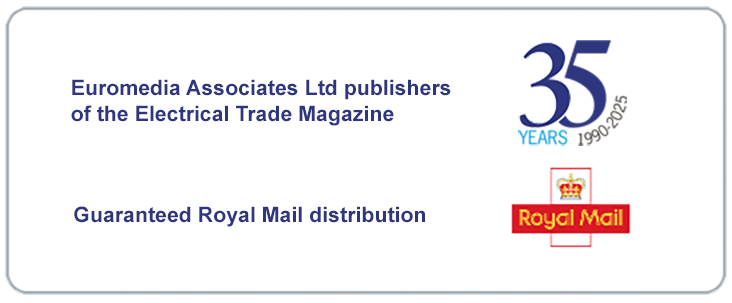In the UK, residual current protection has been installed with little consideration for the nature of appliances and loads connected downstream of the RCD, this can affect the operation of the RCD.
Appliances used in domestic, agricultural and commercial premises, including certain types of washing machine, induction hobs, LED lighting, pumps etc. can produce residual currents that are not compatible with type AC RCDs. The general safety guidance given in the 17th Edition for RCDs, is no longer appropriate for many appliances and loads connected in these installations. Consequently the 18th Edition Wiring Regulations have been updated to align with the existing Electrical Safety Standards already adopted in other countries.
The 18th Edition includes additional guidance on the use of specific Types of RCD, based on the characteristics of the residual current produced by the appliance / load. These changes are covered in more detail later in the article – see Regulation 531.3.3
RCD:Generic term for devices that can detect residual currents and are suitable for fault disconnection. Customers and even manufacturers use the term RCD, when they are talking about an RCCB or an RCBO.
The 18th Edition Regs list the following RCD formats:
RCCB:Residual current protection only. Must be used with MCB for overcurrent and short circuit protection.
RCBO: MCB + Residual current protection. Final circuits providing 30 mA protection.
CBR:MCCB + Residual current protection (Non-domestic >100A)
AFDD: RCBO* + Arc Fault protection. Final circuits
*Check functionality offered by the manufacturer.
MRCD:Residual current module used in association with a Circuit Breaker to provide protection.
Note: RCMs(Residual Current Monitors) are not suitablefor providing residual current protection and cannot be used in place of an RCD – see note in clause 411.1
Terminology
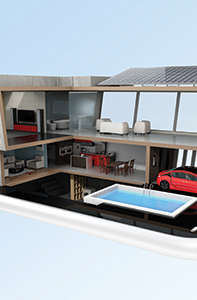 To select and apply residual current devices correctly, requires a basic understanding of the associated Jargon. The term RCD in its self is often incorrectly used – Definitions for some common terms are listed below, refer to Part 2 of BS7671 for a full list associated with the Regulations.
To select and apply residual current devices correctly, requires a basic understanding of the associated Jargon. The term RCD in its self is often incorrectly used – Definitions for some common terms are listed below, refer to Part 2 of BS7671 for a full list associated with the Regulations.
Earth Leakage Current (Protective Conductor Current): Electrical appliances, connections and cables allow some current to leak to earth, due to internal or natural capacitance associated with the installation. This current should travel to earth via the PE (protective earth) conductor. If the PE conductor is disconnected or faulty (high resistance), a person touching uninsulated parts of the equipment would be subject to the leakage current, that normally flows through the PE conductor. The regulations set limits for protective conductor currents and methods for connecting the protective conductor to the equipment – see 543.7
Residual Current: A fault current that flows to earth, due to an insulation failure within an electrical installation i.e. the difference between the current flowing into and out of system via the live conductors.
Types of RCD
The 18thEdition includes new guidance on the use of specific types of RCD for Allinstallations. Regulation 531.3.3 refers to the use of AC, A,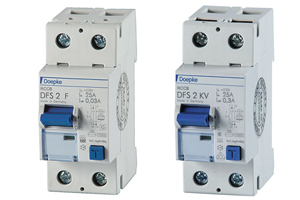 F and B Type RCDs, along with the details of the associated residual current limits. This information is summarised in the table on page 3. When dealing with customers, get into the habit of verifying the Type of RCD to ensure you supply the correct device. Manufacturers use standard pictograms (see table page 3), to indicate the different types of residual current that can be detected by the device.
F and B Type RCDs, along with the details of the associated residual current limits. This information is summarised in the table on page 3. When dealing with customers, get into the habit of verifying the Type of RCD to ensure you supply the correct device. Manufacturers use standard pictograms (see table page 3), to indicate the different types of residual current that can be detected by the device.
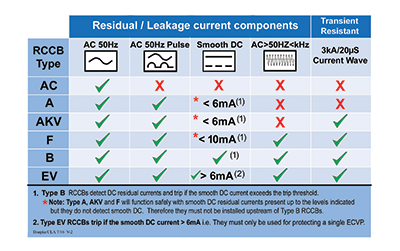 Transient Resistant
Transient Resistant
Switching on specific appliances or a combination of electrical loads such as LED lighting can produce electrical transients in the order of several 1000 amps for a very short duration. These transients can cause nuisance tripping of standard non-delay Type AC and A RCDs. To overcome this problem, RCDs including 30mA devices, can be manufactured with transient resistant features- see right hand column in the table. Type
AKV, F, B and EV RCDs can withstand a fast transient <3kA/20µs. e.g. the Regulations recommend the use transient resistant RCDs, if the circuit contains surge protection devices (SPDs) on the load side of the RCD.
Selective / Time delay
These devices have extended tripping times and a transient resistant feature as standard. For reasons of safety, 30mA devices cannot be supplied with time delay characteristics.
To achieve full discrimination with a 30mA device, the upstream RCD must be at least 300 mA Selective. i.e. the characteristics of the 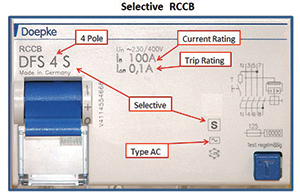 devices do not overlap at any point in the diagram opposite. Using a 100mA with 30mA device could result in both devices tripping under certain fault conditions. Selective RCDs are available in Type AC, A and B versions.
devices do not overlap at any point in the diagram opposite. Using a 100mA with 30mA device could result in both devices tripping under certain fault conditions. Selective RCDs are available in Type AC, A and B versions.
Ask the right questions
Specifying or ordering the wrong product can be very costly and annoying for your customers. You cannot resell a safety product that has been installed, and your customer may not realise that they have the incorrect product until they reach the point of testing the installation. Use this 6-point check list to save you, time, money and heartache at later stage.
- Which RCD format?
- If you are asked for an RCD, confirm RCCB, RCBO etc.
- Rating in Amps – Maximum continuous current?
- RCCBs with higher current ratings can be used, if a lower rating is not available.
- RCBOs, CBRs, AFDDs; select based on current + characteristic (like an MCB)
- Number of switched Poles?
- RCCB:2 or 4 Pole
- RCBO: 1, 2 or 4 Pole
- AFDD: 2 Pole (domestic)
- CBR: 4 Pole
- Rated residual operating current in mA?
- < 30 mA People / Additional Protection
- < 300 mA Fire Protection
- >300 mA Fault Disconnection only
- Any other information relating to the application?
- Selective / Time delay characteristics for 100 mA or greater
- Any specific requirements relating to the Location / Application?
- Types of RCD?
- Confirm the Type of RCD required with the Customer.
18th Edition future-proof
The new Regulations incorporate existing electrical safety standards, recognising the need to verify the selection of the RCD, based on the residual current characteristics of the appliance or loads connected to the installation. Specific applications and locations may require specialist knowledge and specify minimum RCD requirements such as EV Charging Installations and Medical Locations – Refer to Section 7 of the Wiring Regulations and any associated Codes of Practice.
Regulation 531.3.3 covers general application areas and futureproofs the Regulations regarding RCD protection i.e. as new appliances are introduced to the market; the selection of the RCD will be verified with reference to the residual currents that may be generated by the appliances. Refer to the Appliance Manufacturers instructions. The manufacturer of the products you sell, should be able to offer technical support for specific applications. For additional information on RCDs principles and selection, download Doepke Techpub-16.
C.Andrews. Technical Manager Doepke UK Ltd






